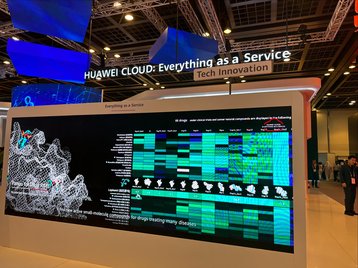With COP28 in Dubai looming, stakeholders are striving to find answers to the climate emergency against a backdrop of unprecedented weather worldwide and meet demands for an increasing amount of energy.
September 2023 set the record for the most extreme heat record in history with the highest monthly global average temperature ever recorded, which was more than 2.59 degrees Fahrenheit (1.44 degrees Celsius) above pre industrial levels.
Governments can create rules and laws governing technology but they don’t create solutions. The responsibility for innovation falls to corporations, their customers and society in general. With new, fast evolving technology, the challenge is how to predict future use and needs while continually innovating to find green solutions. This means every industry is under pressure to reform.
This year ‘Technology and Innovation’ is one of the core themes at Cop28. At the conference, the International Telecommunication Union (ITU) and partners spanning the UN, governments, businesses, and civil society will convene the Green Digital Action Track to step up digital-technology-driven climate action.
The Green Digital Action Track recognizes the crucial role digital technologies play in climate monitoring, climate change adaptation and early warning systems, and mitigation measures. It aims to bring together the ICT community to co-create and fast-track practical solutions and bold action to support the climate agenda.
Host country the UAE is also keen to galvanize the global tech ecosystem towards climate efforts. At the Climate Tech Forum in Abu Dhabi in May, Sultan al-Jaber, COP28 president, described technology as the single most critical source in helping to fight against climate change. So what are the ways in which technology can support?
Technology does not operate in isolation but is already demonstrating its potential as an enabler. For example, the application of AI as part of the digitalization of traditional industries is creating efficiencies and lowering energy consumption even in industries focused on producing energy, such as solar power and mining.
Creating digital infrastructure models such as a three-tier solution of green operations, green networks and green sites makes it easier to measure and utilize joint industry standards. Increasing the amount of available renewable energy is critical to meet our need for a digitalized world. In addition, we can make electricity grids more efficient.
Cloud computing is making increasing demands on public and private clouds as hyperscalers create increasing capacity but also need to consider how much energy they are consuming. Meeting future computing needs necessitates a low-carbon cloud. This includes adjusting energy structures, implementing smart operations and a green supply chain.
Another example of how technology can be adopted relates to weather. Accurate weather forecasts save lives, and early warnings mitigate the worst effects of extreme weather events. But weather forecasting, by its nature, is prone to error.
Conventional weather models that leverage physical equations and observations from satellites, radars, and sensors are limited by inaccuracies, lack of detail and scalability. They also fail to capture the complex and chaotic behavior of our atmosphere. However, prediction based on AI models helps overcome these shortcomings and delivers magnitudes better accuracy.
Using 43 years of data, Pangu-Weather is the first AI prediction model to demonstrate higher precision than traditional numerical weather forecast methods. The model enables a 10,000x improvement in prediction speed, reducing global weather prediction time to seconds. The model can accurately predict in seconds fine-grained meteorological features, including humidity, wind speed, temperature, and sea level pressure.
For example, the European Centre for Medium-Range Weather Forecasts (ECMWF) model, one of the most advanced numerical weather predictions (NWP) methods in existence, takes several hours to generate seven days of global weather forecasts, using thousands of central processing units (CPUs).
By contrast, the Huawei Cloud Pangu-Weather, can achieve similar results in about 10 minutes using a single GPU. For example, Pangu-Weather was able to accurately predict the trajectory of the ‘super typhoon’ Typhoon Doksuri which hit Fujian Province in China during July 2023.
AI can also be used to enable monitoring and managing of deforestation and biodiversity loss. Since 2019 Huawei has worked with over 30 global partners including the IUCN to apply digital technologies to achieve effective conservation and restoration in 46 protected and conserved areas worldwide, from tropical rainforests in China’s Hainan – home to the world’s rarest gibbon, to wetland oasis in Italy, and coral reefs off the east coast of Mauritius.
Implementing next-generation digital technologies, such as cloud computing, IoT, mobile Internet, big data, and AI enables real-time data acquisition and interaction. This is key to improving smart sensing, analysis and management of species protection and area-based conservation efforts, making them more effective and thereby better at conserving nature.
AI's environmental influence goes further and can be used to help reduce greenhouse gas emissions and transition to a low-carbon economy. At Huawei, we support building broad AI ecosystems built on public-private partnership models to boost AI research, regulation, and talent development. This can also help ensure that the benefits of AI are shared equitably across different countries and communities.
AI can play a transformative role in climate change mitigation and adaptation efforts and technology players should be key stakeholders in addressing the climate emergency. With AI, cloud, data storage and continually emerging solutions, global tech companies can facilitate the shift towards the digital transformation of all sectors.
More from Huawei
-

Sponsored Huawei enterprise-class WiFi 7: The world's fastest?
With over 13 Gbps real-world rate, Huawei is redefining the wireless campus network experience
-

Sponsored "In Europe, for Europe": Huawei Cloud is accelerating intelligence
Creating and fostering partnerships in Europe, for Europe
-

Sponsored Make any room a data center with Huawei's FusionModule2000
A successful use case for Indonesian telecoms company Matrix NAP Info


